This is from the interesting website The Horse Lover’s Corral.
1. Safety Rule 1 is “No surprises.” Make sure your horse knows you’re there – approach so he can see you (I usually come in diagonally from the front toward his right shoulder), and talk to him as you do. Position yourself by his shoulder – not in front or behind his leg, where he could kick you; put yourself where a horizontal line drawn from just behind his heels would pass just in front of your toes – and about two feet out. Now, still talking, pet his neck and move your hand down his shoulder and leg (a chance to check the tendon area for puffiness and other problems) to . . .
2. . . . just above the ankle. Grasp his leg at the back, keeping your thumb pretty close to your hand – a safety habit that’s more important with hind legs, as I’ll explain – and tell him to “pick it up.” If he’s used to having his feet handled, he may comply immediately. If not, squeeze in with your thumb and forefinger as you continue asking him to pick the foot up until he obeys. (Always tell him what you want and praise him when he complies – “Pick it up, pick it up, that’s a good boy!” Before long, he’ll pick his foot up himself when you ask.) Then move in a little, being careful your feet aren’t under his; I lean in against the horse a little with my shoulder and elbow so my feet angle out -and slide your hand down to cup the foot and flex the ankle gently. (Not only does this let you see the sole, but it gives you maximum control of his leg.)
3. If you’re right-handed, transfer the foot from your right hand to your left so your right is free to use the hoof pick, which should be fairly blunt – it doesn’t need to be sharp to do its job, and you don’t want to risk wounding your horse. (If you’re left-handed, you’ll switch hands when you’re working on the left foot.)
4. Insert the point into the cleft and run it down one side of the frog, then the other, from heel to toe, to remove caked debris.
5. Then – gently – clean out the cleft in the center of the frog, where a horse with chronic thrush could be tender and sore.
6. Finally, arc your pick around the shoe’s inside rim to clean out anything left clinging there. Then put the foot down, transfer the pick from right hand to left (or put it in your pocket), and . . .
7. . . . let your horse know you’re moving rearward to work on his hind leg. Pat his shoulder and run your hand back along his side, talking to let him know you’re there and staying close (so he can’t do much damage if he decides to kick) as you walk the couple of steps to put yourself beside his quarter.
8. As you did before, lean into your horse as you bend down and keep your feet out from under his. Using your elbow and forearm, not only are you maintaining contact, but if you feel him starting to kick, you can easily push yourself away.
9. Cup your hand around the back of the leg, keeping your thumb close to the rest of the hand. Don’t wrap your thumb around one way and your hand the other way; you could end up with a jammed thumb if he suddenly snaps the leg up and back.
10. Picking up a hind foot is when you need to be most careful about control – if you’re going to get kicked any time, this is it. Keeping your shoulders roughly parallel to your horse’s hip bones and your head well out of the line of fire, slide your hand down until you’re right over the top of the ankle, tell him to “pick it up,” and give a little squeeze. If he doesn’t respond immediately, tap his toe with your foot or your hoof pick to reinforce your message.
11. As the foot comes up, step in toward him so your hip is under him and you can rest his leg on yours, your foot to the inside of where his raised foot would come down. At the same time, grab the toe and flex it up gently. Flexing the foot and supporting his leg this way gives you the greatest possible control; he can’t extend the leg for a kick. Keep the foot flexed as you transfer it from your right hand to your left and the pick from left hand to right. Then clean out the foot as you did the front foot, with your pick pointed away – though for a bar shoe or a heel that’s fit very long, you might briefly turn the pick around to get out that last little bit of dirt. Then put the foot down.
To do the other side, approach your horse from the front again, running your hand down his shoulder, talking and patting him to let him know you’re there. Never walk around behind him; even the best-behaved horse might startle and kick out in self-defense.
© Copyright 1999-2003 The Horse Lover’s Corral

